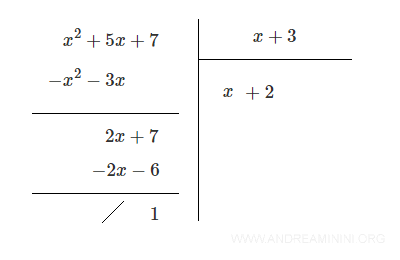Remainder Theorem
When dividing a polynomial by an expression of the form $$ \frac{P(x)}{x-k} = Q(x) + R $$ the remainder R is equal to the value of the polynomial P(x) evaluated at x = k: $$ P(k) = R $$ Here, k is the constant term from the divisor written in the form (x - k).
This is a fundamental property of polynomial division by a linear binomial of the form (x - k).
The theorem provides a shortcut for finding the remainder without having to carry out the full division.
Important: This result applies only when dividing by a binomial of the form (x - k). It does not hold for general polynomial division.
A practical example
Let’s consider the division of two polynomials:
$$ \frac{x^2 + 5x + 7}{x + 3} $$
We perform the division:

The result is a quotient Q(x) = x + 2 with a remainder R = 1.
$$ \frac{x^2 + 5x + 7}{x + 3} = x + 2 \ \ \ \ \text{with remainder } R = 1 $$
According to the Remainder Theorem, the value of the polynomial evaluated at x = k should equal the remainder:
$$ P(k) = R \ \ \ \ \text{where } x = k $$
In this case, the divisor is (x + 1).
To apply the theorem properly, we rewrite it in the standard form (x - k):
$$ (x - (-1)) = (x + 1) $$
So here, k = -1.
Let’s evaluate the polynomial at x = -1:
$$ P(-1) = x^2 + 5x + 7 $$
$$ P(-1) = (-1)^2 + (-1) \cdot 5 + 7 $$
$$ P(-1) = 1 - 5 + 7 $$
$$ P(-1) = 3 $$
So, P(-1) = 3, which matches the remainder R = 3 from the division.
Proof of the theorem
The proof of the Remainder Theorem is straightforward.
Start with the division of a general polynomial P(x) by (x - k):
$$ \frac{P(x)}{x-k} = Q(x) \ \ \ \text{with remainder } R $$
Multiplying both sides of the equation by (x - k):
$$ \frac{P(x)}{x-k} \cdot (x - k) = Q(x) \cdot (x - k) \ \ \ \text{with remainder } R $$
Simplifying the left-hand side gives:
$$ P(x) = Q(x) \cdot (x - k) + R $$
Now substitute x = k into the equation:
$$ P(k) = Q(k) \cdot (k - k) + R $$
Since (k - k) = 0, the first term vanishes:
$$ P(k) = 0 + R $$
$$ P(k) = R $$
This confirms the validity of the Remainder Theorem.
And that's all there is to it.
